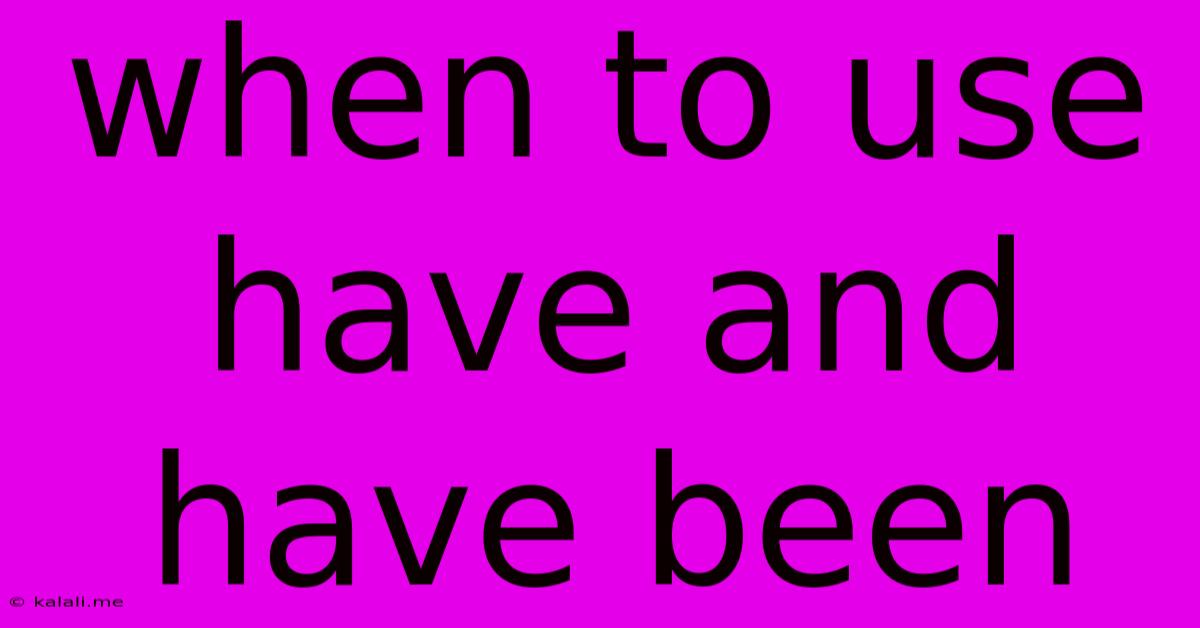When To Use Have And Have Been
Kalali
May 28, 2025 · 3 min read

Table of Contents
When to Use "Have" and "Have Been": A Comprehensive Guide
Understanding the difference between "have" and "have been" can be tricky, even for native English speakers. Both are auxiliary verbs, often used to form perfect tenses, but their usage depends heavily on the context and the aspect of the verb they accompany. This guide will clarify when to use each, providing clear examples to solidify your understanding.
This article will cover the nuances of using "have" and "have been," explaining perfect tenses and the continuous aspect, helping you choose the right verb for any situation. By the end, you'll confidently distinguish between these two commonly confused auxiliary verbs.
Understanding Perfect Tenses
The core difference lies in the tense they help construct. "Have" is primarily used to form the present perfect tense, while "have been" is crucial for forming the present perfect continuous tense. Let's break down each:
-
Present Perfect (Have + Past Participle): This tense describes actions completed at an unspecified time before the present. It emphasizes the completion of the action, not the specific time it happened.
- Example: I have finished my work. (The time of completion is not specified.)
-
Present Perfect Continuous (Have Been + Present Participle): This tense highlights an action that started in the past and continues up to the present, emphasizing the duration of the action.
- Example: I have been working on this project all day. (The action started earlier and continues into the present.)
Key Differences and Examples
Here's a table summarizing the key distinctions and providing more examples:
| Verb Form | Tense | Meaning | Example |
|---|---|---|---|
| Have + Past Participle | Present Perfect | Action completed at an unspecified time before now. | I have eaten lunch. |
| Have Been + Present Participle | Present Perfect Continuous | Action started in the past and continues to the present, emphasizing duration. | I have been studying English for five years. |
Let's delve into more nuanced examples to illustrate the differences further:
Scenario 1: Describing a Completed Action
- Incorrect: I have been finished my homework.
- Correct: I have finished my homework. (Focus is on the completion of the homework.)
Scenario 2: Emphasizing Duration
- Incorrect: I have learned Spanish for two years.
- Correct: I have been learning Spanish for two years. (Focus is on the ongoing nature of the learning process over a period of time.)
Scenario 3: Stressing Recent Completion
Sometimes, both tenses are grammatically correct, but the nuance changes.
- I have written a novel. (The novel is finished, the focus is on the accomplishment)
- I have been writing a novel. (The novel may or may not be finished; the focus is on the process of writing.)
Conclusion: Choosing the Right Verb
Choosing between "have" and "have been" hinges on whether you want to emphasize the completion of an action or its duration. Consider the aspect you want to highlight—completion or ongoing duration—to select the appropriate auxiliary verb. Mastering this distinction will significantly improve the precision and clarity of your writing and speaking. By understanding the perfect and perfect continuous tenses, you can confidently express your ideas with grammatical accuracy.
Latest Posts
Latest Posts
-
If Someone Has A Phd Are They A Doctor
May 29, 2025
-
Meaning Of Bend It Like Beckham
May 29, 2025
-
How Long Do Bananas Take To Grow
May 29, 2025
-
How To Make That Some My Message Go To Spam
May 29, 2025
-
Squealing Belt On Car When Starting
May 29, 2025
Related Post
Thank you for visiting our website which covers about When To Use Have And Have Been . We hope the information provided has been useful to you. Feel free to contact us if you have any questions or need further assistance. See you next time and don't miss to bookmark.